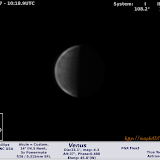Be sure to get to the bottom of this for something unique that I've never done before!
Weak spring astronomy weather, shoot three planets to make up for it. YES!
I shot Venus, then Jupiter and finally Saturn. I'll lead off with Jupiter since it's not as big as it used to be and well past peak.
Sporting a view of the little red spot, this is probably my last view for the year. Although.... it's proximity to Venus might allow me a few more tries if the weather clears back up.
Rest of this spotty season here - https://plus.google.com/photos/+MichaelAPhillips/albums/6110337235125938065
Previous Jupiter seasons here - http://maphilli14.webs.com/jupiter
Next up is a pretty nice looking Saturn. At a low altitude of 37° altitude, this will be hard to beat this year. The rings have opened up to 24° since being edge on in 2009
The rest of 2015 is here - https://photos.google.com/u/0/album/AF1QipMDzUOnk6T0QJnWMeivPCpLE3TwLgN6oK7dqLed
You can view all years of my own photos of Saturn here - http://maphilli14.webs.com/saturn
Finally and oddly the first photo of the night is Venus. This image is in false color, comprised of Infra-red as Red, UltraViolet as Blue and Green is a 50%/50% blend of those two. I used the UV as a lum al-la this technique (https://www.youtube.com/watch?v=oOeog89qnPY&feature=youtu.be)
All my previous Venus' - https://plus.google.com/photos/+MichaelAPhillips/albums/5856527934636955329?banner=pwa
Now to reward you for all your hard reading! In the past I've shot Venus over a short time period but have not really gotten a chance to show the winds move the clouds. Here's a short, two frame animation showing the cloud movement over just a few 10's of minutes.
Thanks and clear skies!




_rgb_mp+kq.png)




























